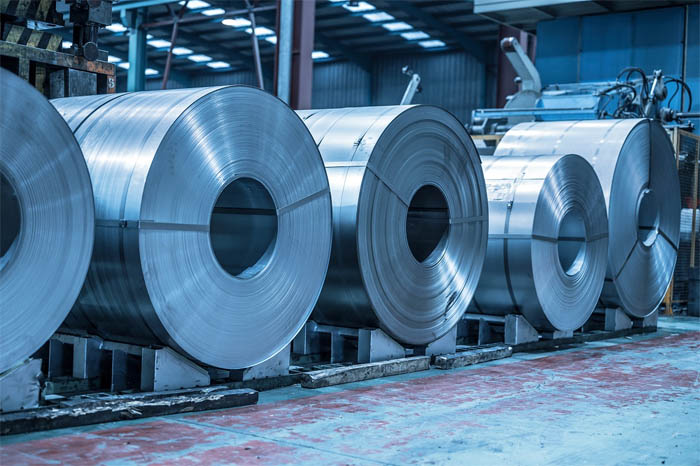What are the different uses of steel coils?

Steel coils refer to a finished steel product that’s manufactured out of slabs. Slabs are considered semi-finished steel materials made from ingots. Producing steel coils out of slabs can be done in different ways — hot rolling, cold rolling, or electrolytic tinplate (EPT). Once all of the major production processes have been completed, the resulting rolled material can now be used in various industries for assembly or further fabrication. Knowing this, steel coil uses can vary depending on the industry, but some of its most popular and widely-known applications include pipe-manufacturing, structural steel members, electronic components, consumer goods, automotive parts, and many more.
As mentioned before, steel coil manufacturing involves taking a slab and then placing them into a continuously rolling machine that reduces its thickness. The result is durable, high-grade, ductile, and high-strength steel sheets that are wound into coils. Read on to learn more about its uses.
Automotive Parts
Automotive parts manufactured from steel coils can be found almost anywhere in a vehicle — from the chassis framework, car doors, exhaust, dashboard system, wheels, rims, engine, suspension, and the like. The high strength-to-weight ratio, durability, heat resistance, and non-combustibility of steel coils make them ideal due to the heat produced in a vehicle’s combustion engine. Like electronic consumer goods, vehicle parts will remain intact when steel coils are used.
Aside from these already-existing automobile parts. Products made out of steel coils have also been the go-to material for car manufacturers. Steel coils can be recycled endlessly and indefinitely without losing their most crucial properties. Any scrap steel coil can be refined and milled again to become new vehicle parts. Moreover, car components and vehicle manufacturers are constantly experimenting with steel to come up with innovative solutions to improve vehicle safety and user experience.
Pipe-Manufacturing
The most common use for steel coils can be found in pipe manufacturing. Pipes such as ERW (Electronic Resistance Welding) and seamless pipes begin with an uncoiled sheet of metal that passes through a continuously rolling machine. The aim of this method is to fuse the two joints of the rolling process through ERW without using any welding filler compound. As ERW pipes do not depend on heat furnaces or high-temperature, it’s classified under cold-forming pipe manufacturing which reduces internal stresses of the pipe, whether during storage or in use.
An alternative pipe-making technique is used for spiral pipes, however, it still begins with a sheet of metal that is wound at an angle. This will allow the weld to run around the outer surface of the pipe in order to form a helix-like structure with the joints all welded together.
Structural Steel Members
In applications wherein high tolerances are not necessarily required, steel coils are preferred. This is due to the high weld-ability, ductility, and machinability of the steel sheets when they’re unwound. Using any type of metal fabrication machine, press breaks, or stamping machine, steel coils can be transformed into exceptional structural steel members, such as I-beams, H-beams, angle bars, wide flange beams, and more.
Structural steel members are found in almost every type of building. For example, they provide framework support for a structure’s walls or enclosures. Steel beams are sturdy enough to support different building materials and they can also be joined using different types of couplings or steel connections. These beams can also be found in a building’s ceiling structure — steel trusses and rafters provide ample support to resist wind loads and keep the ceiling structure intact.
Electronic Equipment
Steel has a high melting point, making sheet metals suitable for use in electronic goods. Some examples would be CPU housings, mobile phone cases, heat sinks, iron cores, circuit boards, and the like. As these components require electrical energy to function, they may end up producing high heat levels that can affect the other parts.
Fortunately, the high melting point of steel coils allows all of these parts to work together without the anger of high temperatures that may destroy the parts. Steel coils also make a good choice because they are easy to fashion and require very little maintenance. Any electronic device that you have at home, made out of steel is a cost-effective purchase due to the material’s properties.
Metal-Stamped Parts
Finally, on a broader application, steel coils are widely used in different metal stamping processes like shearing, notching, flanging, or cutting. Once again, steel coils are extremely malleable, whether for hot-forming or cold-forming stamping. They can easily be shaped in any kind of form and can be used for achieving high tolerances.
Metal-stamped steel coils have benefitted all industries — from automotive, industrial, petrochemical, logistics, construction, food & beverage, and many more. In fact, almost all steel products that you’ll find around you are made out of stamped steel coils, making them a versatile material.
Key Takeaway
As discussed in this article, steel coil uses can be classified into the following: pipe-making, steel beams/members, automotive components, metal-stamped parts, and electronic devices. Although steel coil manufacturing seems simple — i.e. by beginning with a semi-finished steel slab — it has been essential in delivering different types of finished steel parts and goods to be used in different ways.
In need of high-quality steel coils? Hebei Xuanxian has the right selection for you. Click here to learn more! You may also reach us here for more information on our products and services.


评论
发表评论